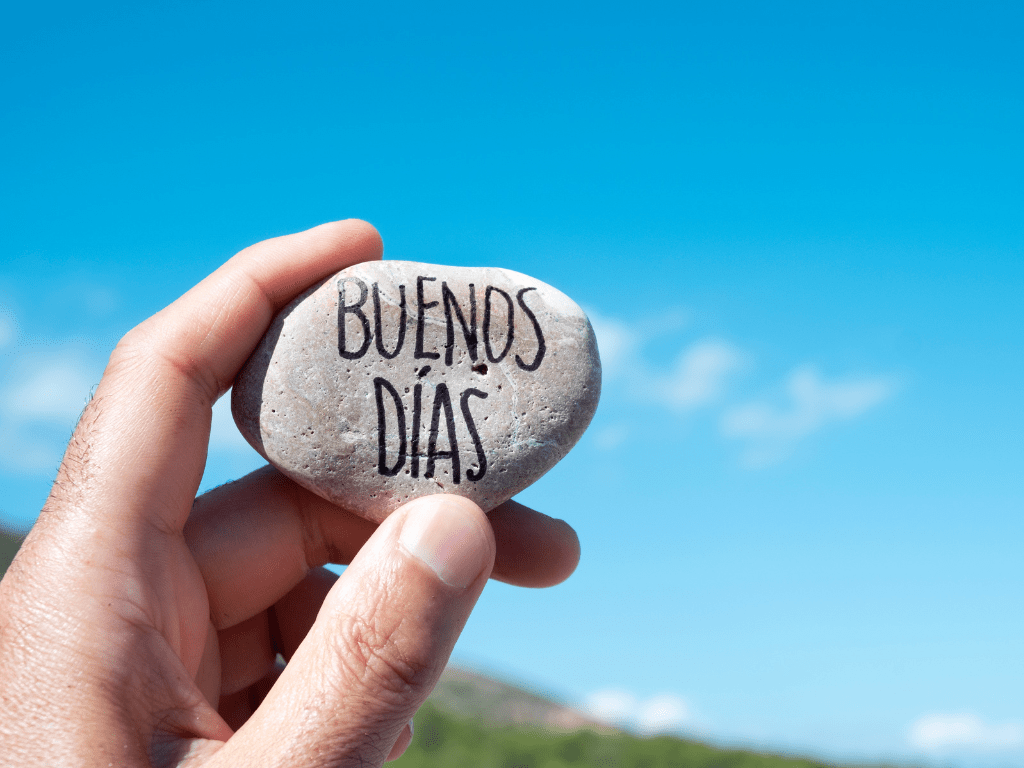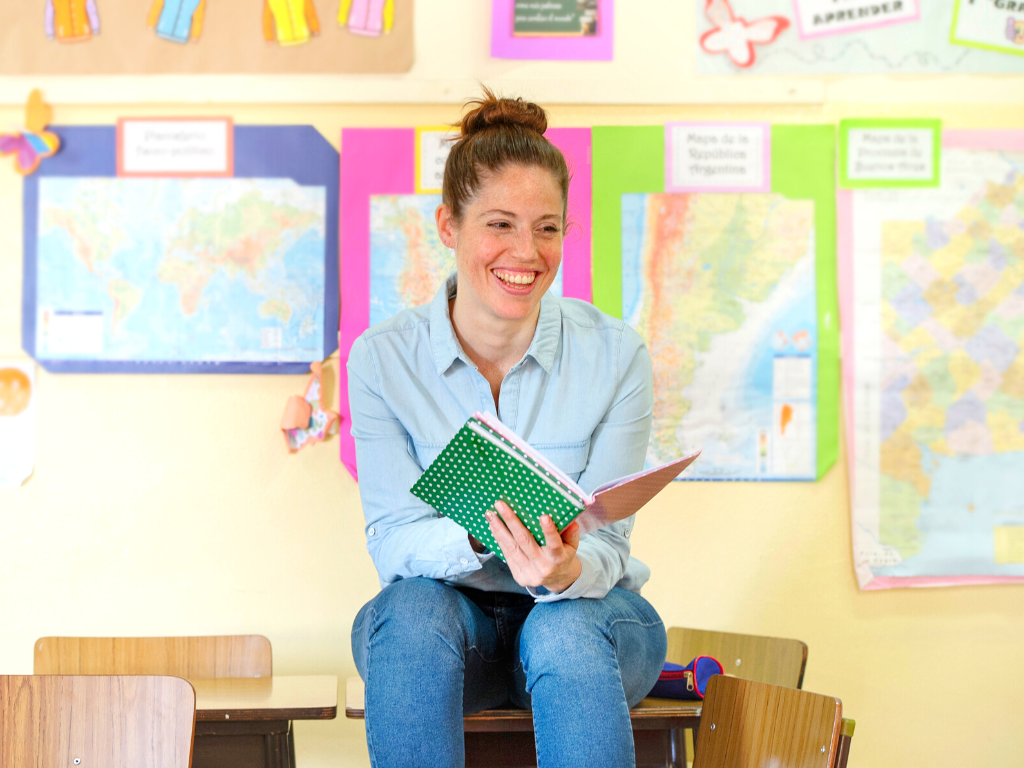Good Morning in Spanish: 47+ Different & Useful Ways
How do you say, “good morning” in Spanish? Let me count the ways!
Learning how to say “good morning” in Spanish is essential if you want to spend some time in a Spanish-speaking country.
Whether you want to greet your roommates or colleagues, buy a train ticket, or order a coffee, knowing how to say good morning will allow you to have positive and natural interactions with Spanish speakers.
And I should know. Not only have I lived in a Spanish-speaking country, but I’m also a former Spanish teacher with a Master’s degree in Foreign Language Education!
In this post, I’ll teach you 47+ different ways of saying “good morning” in Spanish, including common morning greetings and sayings.
How Do You Say Good Morning in Spanish?

1. Buenos días – Good Morning in Spanish
🔊 ‘bwenos dias | bwe-nohs dee-yas
The most basic way of saying good morning in Spanish is Buenos días.
If you think about the literal translation, good morning in Spanish can be a little bit confusing! Actually, Buenos means good and días means days (plural), so the literal translation is good days rather than good morning.
Even more confusing, morning in Spanish is mañana, but it’s not appropriate to say buena mañana in Spanish.
But, don’t let this trip you up! Just remember, Good morning in Spanish is Buenos días.
Why is it Buenos días and not Buenas días?

One of the hardest aspects of the Spanish language for English speakers to master is the concept of subject-adjective agreement.
To explain, all nouns in Spanish have a gender (masculine or feminine) and number (singular or plural). You can tell the gender of a noun by its article (el or la) and by its ending (typically -o or -a). (El and la roughly translate to “the” but are not necessarily said aloud in English.)
Any adjective that describes a noun must match the noun in number and gender.
You can see how this works with these singular nouns, below:
- el pajaro bonito → pretty bird
- el gato loco → crazy cat
- la mesa alta → high table
- la silla fea → ugly chair
To make them plural, you change the articles and endings like this:
- los pajaros bonitos → pretty birds
- los gatos locos → crazy cats
- las mesas altas → high tables
- las sillas feas → ugly chairs
Following these grammar rules, you’re probably wondering why it’s Buenos días and not Buenas días.
The answer is…there are always exceptions when it comes to Spanish grammar!
One such exception is the word día. 🚫
Although it ends in -a, día is actually a masculine word → el día
Following subject-adjective agreement rules, you’d use Buenos días.
Notice how afternoon and evening greetings are feminine (-e is usually an indicator of a feminine noun), so they match with the -as in Buenas:
- El día → Buenos días
- La tarde → Buenas tardes
- La noche → Buenas noches
I know, it can be hard to remember all this as a beginner! But all you have to remember is that el día means you use Buenos días.
How to Pronounce Good Morning in Spanish
Although Spanish grammar can be a little tricky, the pronunciation is relatively easy!
First off, almost all the letters in Spanish only have one sound including the vowels.
Spanish is also a phonetic language. Basically, you pronounce all the letters you see.
Once you know how letters sound, you’ll be able to pronounce almost any word you see written in Spanish. 👏
So, let’s give it a try. Here is how to pronounce (and spell) good morning in Spanish:
Buenos días → bwe-nohs dee-yas
If you’re less familiar with the language, it might be helpful to practice your Spanish pronunciations using the video, below. ⤵
When to Say Buenos Días

An important factor to consider when greeting someone in Spanish is the difference in how different cultures view time.
For example, in most English-speaking cultures, the afternoon starts at noon. This is true for many Latin American countries as well.
Thus, at noon, you can switch from saying Good morning to Good afternoon.
However, some countries begin their afternoons later than 12:00 pm! For instance, Spaniards say Buenos días until about two o’clock in the afternoon in Spain!
This is because lunchtime in countries like Spain starts around 2 pm. Between lunch and dinner (which is often late in the day), people will say Buenas tardes, which is Good afternoon in Spanish.
If you’re wondering when to switch from Buenos días to Buenas tardes, research the individual Spanish-speaking country you’re visiting — or ask a native speaker!
Is it Important to Say Good Morning in Spanish?
Yes, it’s important to know how to say good morning in Spanish. This greeting is integral to connecting with locals in Spanish-speaking countries.
In most Spanish-speaking countries, it’s expected that you’ll greet shopkeepers, waiters, and even when you’re asking strangers for directions! Not doing so can be considered rude.
Instead, try to start all your encounters politely. A simple Buenos días in the morning will set the tone for a positive interaction.
Depending on which country you visit, you’ll find varying degrees of warmth coming from others. But don’t worry, even if the person doesn’t smile or seem very responsive, your morning greeting still means a great deal.
Other Morning Greetings in Spanish

As you travel, and the more comfortable you get with your Spanish, you’ll likely desire to expand your vernacular by saying some other greetings besides Good Morning. Here you’ll find a few suggestions for morning wishes in Spanish.
2. Buenas – Hello
🔊 ‘bwenas | bwe-nahs
Derived from Buenos días, Buenas is a short, casual greeting used in some parts of the Spanish-speaking world (We used this almost exclusively when I was living in Valencia, Spain).
You can technically use it at any time of the day to mean hello, but when you use it in the morning, it’s understood as good morning.
3. ¡Buenos! – Morning!
🔊 ‘bwenos | bwe-nohs
Buenos is a shorter version of Buenos días used in some Spanish-speaking countries, meaning, Morning!
4. ¡Buen día! – Good day!
🔊 ‘bwen dia | bwen dee-yaa
Buen día means Good day in Spanish. This phrase is typically used in countries like Mexico, Argentina, and several Central American countries and can be used to greet someone at any time of day.
5. Hola – Hello
🔊 ola | oh-la
Hola is Hello in Spanish, and you can say Hola any time of day! Just like in English, however, hola could be considered more informal than other greetings. If you’re meeting someone for the first time or approaching someone in a shop, for example, it may be better to err on the side of caution and use a more formal greeting like Buenos días.
It’s also common to say, Hi, good morning: Hola, buenos días.
7. Saludos – Greetings
🔊 saluðos | sah-loo-dos
An additional way to say “Good morning” in Spanish is saludos. Saludos means “greetings”, and and can be used for both morning and afternoon.
It’s very common to use the word in written form, for example, at the end of an email. In this case, it means something similar to regards or cordially.
8. ¡Qué tengas un buen día! – Have a great day!
🔊 ˈke teŋgas un bwen ˈdia | ke ten-ɡas um bwen dee-ya
If you want to tell someone to have a good day in Spanish, you can use the phrase que tengas un buen día. This is a very common way to say have a good/great/nice day in Spanish-speaking countries.
You can use the saying with anyone, from friends and family to co-workers and strangers—whenever you or they are leaving.
Remember, with this phrase, you need to conjugate the verb tener (to have) depending on who you’re speaking to:
- Que tengas buen día – Have a good day (casual)
- Que tenga buen día – Have a good day (formal)
- Que tengan buen día – Have a good day (addressing a group, informally or formally)
To emphasize, and say I hope you have a good day in Spanish, add the word Ojalá (oh-hah-lah). Ojalá means I hope in Spanish.
- Ojalá que tengas buen día – I hope you have a good day (casual)
- Ojalá que tenga buen día – I hope you have a good day (formal)
- Ojalá que tengan buen día – I hope you all have a good day (addressing a group, informally or formally)
9. ¡Qué tengas un gran día! – Have a great day!
🔊 ˈke teŋgas un gɾan ˈdia | ke ten-ɡas un gran dee-ya
To wish someone a great day in any setting, you can say que tengas un gran día.
Here’s how you conjugate the verb tener (to have) depending on who you’re speaking to:
- Que tengas un gran día – Have a good day (casual)
- Que tenga un gran día – Have a good day (formal)
- Que tengan un gran día – Have a good day (addressing a group, informally or formally)
Just as in the previous example, you may add Ojalá to say, I hope you have a good day in Spanish: Ojalá que tengas un gran día
8. ¡Qué tengas un lindo día! – Have a nice day!
🔊 ˈke teŋgas un lindo ˈdia | ke ten-ɡas un lin-do dee-ya
To wish someone a nice day in any setting, say que tengas un lindo día.
Here’s how you conjugate the verb tener (to have) depending on who you’re speaking to:
- Que tengas un lindo día – Have a nice day! (casual)
- Que tenga un lindo día – Have a nice day! (formal)
- Que tengan un lindo día (to a group, informally or formally) – Have a nice day!
Feel free to add Ojalá to say, I hope you have a nice day in Spanish: Ojalá que tengas un lindo día
10. ¿Qué tal tu mañana? – ¿How’s your morning going?
🔊 ˈke tal tu maɲana | kay tahl too mahn-yah-nah
You might say Qué tal tu mañana? to ask someone how their morning is going. This question typically works best mid-morning, and is rather informal.
Alternatively, you can ask someone ¿Cómo va tu mañana? (koh-moh ba too mahn-yahn-ah) to ask someone how their morning has been. This expression directly translates to How is your morning going? To address someone formally, use the pronoun su: ¿Cómo va su mañana?
11. ¿Cómo le va el día? – How’s your day going?
🔊 ˈkomo le ba el ˈdia | koh-moh leh ba el dee-yah
For a more polite way to ask how someone’s day is going in Spanish, try using the expression ¿Cómo le va el día? It’s always better to use a more formal way of greeting someone if you don’t know them well or if you’re meeting them for the first time.
Thus, this morning greeting would work well when meeting new coworkers, for example.
12. ¿Cómo estás esta mañana? – How are you this morning?
🔊 ˈkomo eˈstas esta maɲana | koh-moh eh-stahs es-stah mahn-yah-nah
To ask someone how they are in the morning, you can say:
- ¿Cómo estás esta mañana? (casual)
- ¿Cómo está esta mañana? (formal)
- ¿Cómo están esta mañana? (to a group, informally or formally)
13. Que tengas una bonita mañana – Have a nice morning
🔊 ke teŋgas una bonita maɲana | ke ten-ɡas ooh-na bo-nee-tah mahn-yah-nah
To tell some, “Have a nice morning,” rather than a nice day you can say:
- Que tengas una bonita mañana (casual)
- Que tenga una bonita mañana (formal)
- Que tengan una bonita mañana (to a group, informally or formally)
If you’d like to add emphasis by adding I hope to the beginning of the sentence, simple add Ojalá to mean, I hope you have nice morning in Spanish: Ojalá que tengas una bonita mañana
14. ¡Qué hermosa mañana! – What a lovely morning
🔊 ˈke eɾˈmosa maˈɲana | ke er-moh-sah mahn-yah-nah
To declare that the weather is nice or the day is beautiful, use the expression ¡Qué hermosa mañana! This means What a lovely morning! Or What a beautiful morning! This expression can be used with anyone.
You can simply say ¡Qué hermosa mañana! on its own, or you can add the word, ¿no? to the end like this to elicit a response:
- Qué hermosa mañana, ¿no? – What a beautiful morning, right? Or What a lovely morning, isn’t it?
Good Morning in Spanish with Titles

If you want to address the person(s) you’re talking you, you can add a title, noun, or name to your good morning wishes in Spanish. This can show politeness, or it can help you to be more direct with your language.
15. Buenos días a todos – Good morning, everyone
🔊 bwenos ˈdias a ˈtoðos | bwe-nohs dee-yas ah toh-dos
If you want to say good morning to all in Spanish, you can say Buenos días a todos. This is great if you’re addressing a group of people at work or when you come downstairs in the morning to greet your host family or roommates.
Buenos días a todos roughly means Good morning all, ya’ll, everyone, you guys, etc.
16. Buenos días, señor – Good morning, sir
🔊 bwenos ˈdias seˈɲoɾ | bwe-nohs dee-yas seh-nyor
To say good morning in Spanish to a man, use the phrase, Buenos días, señor.
Señor means sir or mister. It’s used more often than in English and can be used to address any man, particularly a man who is older than you or in a position of authority. It’s considered polite and formal, so you wouldn’t typically use this for male friends or family.
17. Buenos días, señora – Good morning, ma’am
🔊 bwenos ˈdias seɲoɾa | bwe-nohs dee-yas seh-nyo-ra
Say Buenos días, señora if you want to say good morning in Spanish to a woman. This would be the equivalent of saying Good morning ma’am in English. This is typically only used for married women, older women, or women in a position of authority.
It comes across as respectful and polite, thus you do not need to address women as señora in a casual situation, such as among friends.
18. Buenos días, señorita – Good morning, miss
🔊 bwenos ˈdias seɲoˈɾita | bwe-nohs dee-yas seh-nyoh-ree-tah
If you come across a younger woman or girl, you can say Buenos días, señorita to show respect. This means good morning miss.
19. Buenos días, señoras y señores – Good morning, ladies and gentlemen
🔊 bwenos ˈdias seˈɲoɾas i seˈɲoɾes | bwe-nohs dee-yas seh-nyor-ahs e seh-nyor-ehs
If you’re addressing a crowd, such as at a speaking event, you can say Buenos días, señoras y señores to mean Good morning, ladies and gentlemen. Buenos días, caballeros y caballeras can also be used, depending on the country.
20. Buenos días, chicos y chicas – Good morning, boys and girls
🔊 bwenos ˈdias tʃikos i tʃikas | bwe-nohs dee-yas
To address a group of children, teenagers, or young adults, you can say Buenos días, chicos y chicas. For little kids, it’s appropriate to use Buenos días, niños y niñas.
21. Buenos días, clase – Good morning, class
🔊 bwenos ˈdias klase | bwe-nohs dee-yas
If you’re a teacher or a student giving a presentation to your peers, you can say, Buenos días, clase to greet the class.
22. Buenos días, doctor – Good morning, doctor
🔊 bwenos ˈdias dokˈtoɾ | bwe-nohs dee-yas
Sometimes, you want to address only one person in the room, or you want to use a specific title or name. In this case, simply add the title or name you want to use after the phrase Buenos días like this:
- Buenos días, doctor – Good morning, doctor
- Buenos días, profesora – Good morning, Teacher
- Buenos días, Jorge – Good morning, George
23. Buenos días, amigos – Good morning, friends
🔊 ˈbwenos ˈdias amiɣos | bwe-nohs dee-yas ah-me-goes
You can say Buenos días, amigos if you want to say “good morning friends” or you can say Buenos días, mis amigos if you prefer to say “good morning my friends“.
Romantic Good Morning in Spanish

Italian and French may get all the hype when it comes to romance, but Spanish can be quite romantic and loving, too! Here are some ways to show you love someone while wishing them good morning in Spanish.
24. Buenos días, mi amor – Good morning, my love
🔊 bwenos ˈdias mi amor | bwe-nohs dee-yas mee ah-mor
If you want to be romantic when you wake your partner up in the morning, you can say Buenos días, mi amor which translates to good morning my love in Spanish. This is a sweet way to say good morning in Spanish to a woman or a man.
25. Buenos días, hermosa – Good morning, beautiful
🔊 bwenos ˈdias eɾmosa | bwe-nohs dee-yas er-moh-sah
A cute way to say good morning in Spanish is to say Buenos días, hermosa which means good morning beautiful. This morning greeting is meant for a woman, as you wouldn’t typically tell a man he’s beautiful (hermoso).
26. Buenos días, guapo – Good morning, handsome
🔊 bwenos ˈdias gwapo | bwe-nohs dee-yas wa-po
To tell a man good morning, use Buenos días, guapo. This is a loving way to say good morning, handsome in Spanish. When said to a man, handsome is Spanish is guapo.
You can also say, Buenos días, guapa (bwe-nohs dee-yas wa-pa) to a woman, roughly meaning Good morning cutie/pretty girl. (You can say this romantically or platonically.)
27. Buenos días, mi cielo – Good morning, my sky
🔊 bwenos ˈdias mi θjelo | bwe-nohs dee-yas me-see-eh-lo
Mi cielo is a term of endearment in Spanish meaning, my sky or my heaven. This is similar to how in English people say dear or sweetie. So, if you want to use a term of endearment, you can say, Buenos días, mi cielo.
This can be used romantically or by parents to their children to show they are cherished.
28. Buenos días, corazón – Good morning, heart
🔊 bwenos ˈdias koɾaˈθon | bwe-nohs dee-yas cor-ah-sohn
Mi corazón is a term of endearment to express love in Spanish similar to my love or sweetheart, so feel free to use Buenos días, corazón with your loved one.
Waking Up in Spanish

Besides the typical good morning greetings, there are some common phrases you might like to use when walking up in Spanish. If you have roommates or a host family, you’ll more than likely hear many of the expressions below instead of the rather a formal Buenos días.
29. Levántate y brilla – Rise and shine
🔊 levántate i bɾiʎa | leh-vahn-tah-teh e bree-yah
If you’re studying abroad and have a host mother, she might say, Levántate y brilla to address you informally. This is similar to, Rise and shine!
30. Hora de levantarse – Time to get up
🔊 ˈoɾa ðe leβanˈtaɾse | oh-rah deh leh-van-tar-seh
When it’s time to get up, or time to rise, you say, es la hora de levantarse meaning It’s time to get up.
31. ¡Despierta! – Wake up!
🔊 desˈpjeɾta | des-pee-air-tah
If you want to wake someone up in the morning, you can say, ¡Despierta!
32. ¡Arriba! – Time to get up!
🔊 aˈriβa | ah-RREE-bah
The expression ¡Arriba! is used to encourage someone to get up and is often used in the morning to greet a sleeping child or loved one. People also use it to cheer others on. For example, you’ll hear ¡Arriba! When people are watching sports!
33. ¡Ya amaneció! – It’s daytime already!
🔊 ʝa amaneˈsjo | ya ah-mah-neh-see-oh
If you want to get someone out of bed when they are still asleep, you might use the phrase, Ya amaneció. In this case, the day has already started, and you need them to get up! You should use this in a more casual situation so as not to appear rude.
34. ¿Cómo dormiste? – How did you sleep?
🔊 ˈkomo ðoɾˈmiste | koh-mo door-mee-steh
To ask someone how they slept, simply ask ¿Cómo dormiste? This conjugation is informal, so you might use it with a friend or roommate when sitting around the breakfast table, for example.
To address someone more formally, like a host mom, you’d use ¿Cómo durmió? (ˈkomo | koh-mo dur-mee-oh)
35. ¿Cómo amaneciste? – How are you feeling this morning?
🔊 ˈkomo amaneˈsiste | koh-mo ah-mah-neh-sees-teh
Ask “¿Cómo amaneciste?” to ask someone how they felt when they woke up in the morning. This is similar to asking someone, How did you feel when you woke up?, How are you feeling this morning?, or How did you sleep?
Literally, the English translation is How dawned you? or How did you wake up?
Notice that you can change the conjugation of the verb amanecer depending on who you are talking to:
- ¿Cómo amaneciste? – How are you feeling this morning? (casual)
- ¿Cómo amaneció? – How are you feeling this morning? (formal)
- ¿Cómo amanecieron?– How are you feeling this morning? (to a group, formal or informal)
36. ¿Dormiste bien? – Did you sleep well?
🔊 doɾˈmiste ˈβjen | dor-mees-teh bee-ehn
In Spanish, as in English, it’s common to ask close friends or family members how they slept the night before, particularly early in the morning. For this, you can ask “Did you sleep well?”
- ¿Dormiste bien? (casual)
- ¿Durmió bien?” (formal)
You can also ask someone the question ¿Descansaste bien? (des-cahn-sahs-tay bee-ehn). This means Did you rest? or Did you get some rest? This may be more appropriate in a situation where someone had a long day the previous day and desperately needed rest.
How to Say Morning in Spanish

“The morning” in Spanish is la mañana,
37. La mañana – Morning
🔊 maˈɲana | mah-nyah-nah
Morning in Spanish is la mañana.
38. Esta mañana – This morning
🔊 esta maɲana | mah-nyah-nah
To say, this morning in Spanish, say esta mañana.
39. Por la mañana – In the morning
🔊 por la maɲana | mah-nyah-nah
If you want to say you do something in the morning or you’ll see someone in the morning, use por la mañana.
- Yo almuerzo por la mañana – I eat in the morning
- Te veo en la por la mañana – I’ll see you in the morning
40. El viernes por la mañana – On friday morning
🔊 el bjeɾnes por la maɲana | mah-nyah-nah
If you want to say on a certain morning, use por la mañana with the day of the week.
- Yo iré al dentista el viernes por la mañana. – I’ll go to the dentist on Friday morning.
- Tengo un examen el martes por la mañana – I have a test on Tuesday morning.
41. Ayer por la mañana – Yesterday morning
🔊 aʝeɾ por la maɲana | mah-nyah-nah
To say, yesterday morning in Spanish, say ayer por la mañana.
- Llegué ayer por la mañana – I arrived yesterday morning
41. Mañana por la mañana – Tomorrow morning
🔊 maɲana por la maɲana | mah-nyah-nah por lah mah-nyah-nah
Mañana means tomorrow in Spanish, too! Therefore, you can say mañana por la mañana to mean tomorrow morning.
- Llegaré mañana por la mañana – I arrive tomorrow morning.
How to Reply to Good Morning in Spanish?

If someone says good morning to you in Spanish, you will want to respond in order to be polite and possibly start a conversation.
You can reply with, “Buenos días” which means good morning. Then, to continue the conversation (when appropriate), you can also say things like:
42. Buenos días ¿Cómo estás? – Good morning, how are you?
🔊 ˈkomo eˈstas | koh-moh eh-stahs
Good morning, how are you? in Spanish is Buenos días ¿Cómo estás?
Simply add, ¿Cómo estás? (How are you? in Spanish) if you want to ask someone how they are doing in the morning. It’s quite common to use these two expressions together.
It’s informal, using the conjugation of estar for the familiar you. To address someone politely, say Buenos días ¿Cómo está? (Or Buenos días ¿Cómo están? to address a group.)
43. ¿Cómo te va? – How’s it going?
🔊 ˈkomo te ˈβa | koh-moh
¿Cómo te va? is a common way to say “How’s it going?” or “How are things?” in Spanish, and you can use it to greet someone in the morning. However, this greeting is best used with friends, family, and other people you know well.
5. Buenos días, un placer – Good morning, it’s a pleasure (to meet you)
🔊 bwenos ˈdias un plaθeɾ konoθeɾte | bwe-nohs dee-yas
If you’re meeting someone for the first time, you can follow your Buenos días with un placer. You can use this phrase when you are meeting someone for the first time, and in English it means, “Good morning, it’s a pleasure (to meet you).”
44. Encantado/a – Nice to meet you
🔊 eŋkantað de konoθeɾle |
When meeting someone for the first time in the morning, you can say Buenos días, encantado/a. In English, it means, “Good morning, pleased (to meet you).”
45. Mucho gusto – Nice to meet you
🔊 mutʃo gusto | moo-cho goo-stow
To say “Nice to meet you” in Spanish is mucho gusto. This is phrase you can use when you are meeting someone for the first time. In the morning, you can say Buenos días, mucho gusto to mean, “Good morning, nice to meet you.”
46. ¿Cómo se llama? – What’s your name?
🔊 ˈkomo se ʎama | koh mo seh yah-ma
If you’re meeting someone for the first time, perhaps you’d like to ask for his or her name. To ask for someone’s name politely, say, ¿Cómo se llama?
If you’re in a less formal country, like Spain, or around others your own age, you might use the informal, ¿Cómo te llamas? But if you’re not sure, always err on the side of using polite language so as not to come off as rude.
47. ¿Qué planes tienes para hoy? – What are your plans for today?
🔊 ˈke planes tjenes paɾa oj | ke pla nays tee-eh-nays pa-ra oy
It’s likely you’ll want to ask a friend what plans they have for the rest of the day. In this case, follow up your Buenos días with ¿Qué planes tienes para hoy? This is a great way to start a conversation and learn something about your new friend (and what there is to do in the place you’re visiting).
Good Morning Quotes in Spanish

If you want to wish someone a good morning in Spanish via email, social post, or a homemade card. Here are some sweet good morning quotes in Spanish with English translations you can use:
Muy buenos días
Muy buenos días is another way of saying good morning with the word muy (very), as emphasis. It’s similar to saying, A very good morning (to you).
“Con el nuevo día vienen nuevas fuerzas y nuevos pensamientos.”
This is a sweet morning quote in Spanish from former first lady of the United States, Eleanor Roosevelt. The English translation is, “With the new day comes new strength and new thoughts.”
Que tengas un dia llena de paz y armonia
To wish someone a peaceful day, say, Que tengas un dia llena de paz y armonia. This translates to, Have a day full of peace and harmony
Te deseo una linda mañana
If you’re writing to someone, you may want to wish them a nice morning. A great way to do this is to say, Te deseo una linda mañana. Literally, this means, “I desire a nice morning for you.” But, it’s similar to saying, “Have a nice morning.!” or “I wish you a nice morning.”
“Una caminata temprano en la mañana es una bendición para todo el día.”
This morning quote in Spanish means, “An early-morning walk is a blessing for the whole day.” – Henry David Thoreau
“Solía amar más la noche, pero a medida que envejezco, más tesoros, esperanza y alegría encuentro en las mañanas.”
Here’s a Spanish morning quote you’ll love, especially if you’re getting older and realizing just how much joy you can find in the morning. It means, “I used to love night best but the older I get the more treasures and hope and joy I find in mornings.” – Terri Guillemets
Que este dia te traiga mucha felicidad
A nice good morning wish in Spanish is to say, Que este dia te traiga mucha felicidad. In English, this means, “May this day bring you much happiness.” This expressions would be especially appropriate in written form—on a card, in an email, or as a Spanish Instagram caption.
Feliz lunes
You can add the word, feliz, which means happy to any day of the week to say, Happy Monday! Or Happy Friday (Feliz viernes), for example.
“Escríbelo en tu corazón que cada día es el mejor día del año.”
“Write it on your heart that every day is the best day in the year.” – Ralph Waldo Emerson
This is a lovely quote you can say any morning of the year!
Buenos dias, mi amor. Cada dia te amo mas!
This good morning wish in Spanish means, “Good morning, my love. Every day I love you more!” This is a romantic good morning expression in Spanish that you can say to your significant other.
“La brisa del amanecer tiene secretos que contarte. No vuelvas a dormir.”
We’ve all been tempted to go back to sleep when the alarm wakes us, but this Rumi quote reminds us to get up. We never know what the day holds for us! In English, it means, “The breeze at dawn has secrets to tell you. Don’t go back to sleep.”
Good Morning in Spanish Songs
Songs are a great way to learn Spanish! If you want a song that you (or kids) can sing along to, then check out the following good morning song for children. ⤵
Good Morning in Spanish: Q&A
Let’s answer your most popular questions regarding morning greetings in Spanish!
How do I say good morning in Spanish?
To say good morning in Spanish, simply say, Buenos días!
How do you say hi in Spanish?
To say hi in Spanish, simply say, Hola! You can say hola to anyone at any time of the day.
How do you say hello in Spanish?
To say hello in Spanish, simply say, Hola! You can say hola to anyone at any time of the day.
How do you say How are you in Spanish?
If you want to ask someone how they are doing, say ¿Cómo estás? which means “How are you?” This expression includes the informal verb conjugation of estar. To address someone politely, use ¿Cómo está? or ¿Cómo está Usted? instead.
What is a Good Morning in Spanish Quote for her?
There aren’t many good morning love quotes in Spanish for your sweetheart. Try adding a term of endearment like mi cielo, mi vida, mi amor, or mi carino after Buenos dias.
How do you say Good Afternoon in Spanish?
To say “good afternoon” in Spanish, just say “Buenas tardes.” This expression can be used formally or informally and works both when you are coming or going.
How do you say Good Night in Spanish?
To say “good night” or “good evening” in Spanish, you say “Buenas noches.” This expression can be used formally or informally and works both when you are coming or going.
Are there any funny good morning expressions in Spanish?
There aren’t really any funny ways to say good morning in Spanish, so just stick to the basics. You could always try to spice up what you call someone after you say Buenos días, but be sure you know them well enough that they won’t take it offensively.
What is mañana in English?
Mañana has several meanings in English. First, mañana means morning. Mañana also means tomorrow. To tell them apart when interacting with a Spanish speaker, you’ll need to rely on context.
How do you say Good Morning in French?
Bonjour is “good morning” in French. It also means, hello.
Conclusion: Spanish for Good Morning
Now that you know what to say in the morning in Spanish, you can confidently start your day in the Spanish-speaking world! Simply say, ¡Buenos días! or use any of these sayings whenever you’re greeting someone in the morning in Spanish.
Spanish Language Guides
Want to practice or learn Spanish? Check out these additional Spanish resources! ⤵
- How to Say Omelet in Spanish (5 Different Types)
- Lingopie Review: Everything You Need to Know About the Language Learning Platform
- How to Say For in Spanish: Por, Para, or Something Else?
- How Many Spanish Words Are There in 2024? (Yes, it Changes!)
- 10 Tips for Learning Spanish Quickly from a Spanish Teacher
- What is Gluten Free in Spanish (+ Translation Cheatsheet)
- Free Printable 2024 Spanish Calendar (Color or B&W)
- 240 Spanish Art Words for a Colorful Trip to Spain
- Intercambio in Spain: English/Spanish Language Exchange
- What Does the Spanish “Buen Provecho” Mean in English?
- 19 Festive Ways to Say “Happy New Year” in Spanish
- How Do You Say Merry Christmas in Spanish (33 Ways!)
- Sandwich in Spanish: How to Say “Sandwich” in 21 Ways!
- Happy Halloween in Spanish: 139 Spooky Spanish Words
- 100+ Spanish Words That Start With W (& Words Containing W)
- 30+ Different Shades of Purple in Spanish (w/Hex Codes)
- How to Say Please in Spanish 7+ Different Ways
- 13+ Different Ways to Say Delicious in Spanish (Yummy!)
- Good Morning in Spanish: 47+ Different & Useful Ways
- 13 Common Ways to Say “Where Are You From” in Spanish
- 7+ Authentic Ways to Say Welcome in Spanish
- 13+ Ways to Say Cheers in Spanish for Any Occasion
- 150+ Best Spanish Captions for Instagram (+ English Translation)
- 55 Inspirational Quotes in Spanish About Life & Learning w/Translation
